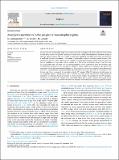Files in this item
Zonal jets experiments in the gas giants’ zonostrophic regime
Item metadata
| dc.contributor.author | Lemasquerier, Daphné | |
| dc.contributor.author | Favier, B. | |
| dc.contributor.author | Le Bars, M. | |
| dc.date.accessioned | 2022-11-08T17:30:14Z | |
| dc.date.available | 2022-11-08T17:30:14Z | |
| dc.date.issued | 2023-01-15 | |
| dc.identifier | 281699945 | |
| dc.identifier | 3d95f934-884c-4dc8-b9d5-d7cd0e1da288 | |
| dc.identifier | 85141279443 | |
| dc.identifier | 000882445200001 | |
| dc.identifier.citation | Lemasquerier , D , Favier , B & Le Bars , M 2023 , ' Zonal jets experiments in the gas giants’ zonostrophic regime ' , Icarus , vol. 390 , 115292 . https://doi.org/10.1016/j.icarus.2022.115292 | en |
| dc.identifier.issn | 0019-1035 | |
| dc.identifier.other | ORCID: /0000-0002-9795-6214/work/121754263 | |
| dc.identifier.uri | https://hdl.handle.net/10023/26333 | |
| dc.description | Funding information: European Research Council (681835-FLUDYCO-ERC-2015-CoG). | en |
| dc.description.abstract | Intense east–west winds called zonal jets are observed in the atmospheres of Jupiter and Saturn and extend in their deep interior. We present experimental results from a fully three-dimensional laboratory analog of deep gas giants zonal jets. We use a rapidly rotating deep cylindrical tank, filled with water, and forced by a small-scale hydraulic circulation at the bottom. A topographic β-effect is naturally present because of the curvature of the free surface. Instantaneous turbulent zonal jets spontaneously emerge from the small-scale forcing, equilibrate at large scale, and can contain up to 70% of the total kinetic energy of the flow once in a quasi-steady state. We show that the spectral properties of the experimental flows are consistent with the theoretical predictions in the zonostrophic turbulence regime, argued to be relevant to gas giants. This constitutes the first fully-experimental validation of the zonostrophic theory in a completely three-dimensional framework. Complementary, quasi-geostrophic (QG) simulations show that this result is not sensitive to the forcing scale. Next, we quantify the potential vorticity (PV) mixing. While PV staircasing should emerge in the asymptotic regime of the gas giants, only a moderate PV mixing occurs because of the strong forcing and dissipation, as confirmed by QG simulations at smaller Ekman number. We quantify the local PV mixing by measuring the equivalent of a Thorpe scale, and confirm that it can be used to estimate the upscale energy transfer rate of the flow, which otherwise needs to be estimated from a much more demanding spectral analysis. | |
| dc.format.extent | 26 | |
| dc.format.extent | 6315698 | |
| dc.language.iso | eng | |
| dc.relation.ispartof | Icarus | en |
| dc.subject | Jupiter | en |
| dc.subject | Saturn | en |
| dc.subject | Atmospheres | en |
| dc.subject | Dynamics | en |
| dc.subject | Experimental techniques | en |
| dc.subject | Planetary dynamics | en |
| dc.subject | QB Astronomy | en |
| dc.subject | QC Physics | en |
| dc.subject | DAS | en |
| dc.subject | MCC | en |
| dc.subject.lcc | QB | en |
| dc.subject.lcc | QC | en |
| dc.title | Zonal jets experiments in the gas giants’ zonostrophic regime | en |
| dc.type | Journal article | en |
| dc.contributor.institution | University of St Andrews. Applied Mathematics | en |
| dc.identifier.doi | https://doi.org/10.1016/j.icarus.2022.115292 | |
| dc.description.status | Peer reviewed | en |
This item appears in the following Collection(s)
Items in the St Andrews Research Repository are protected by copyright, with all rights reserved, unless otherwise indicated.

